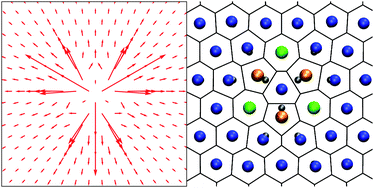Point defects in two-dimensional colloidal crystals: simulation vs. elasticity theory
Abstract
Using numerical and analytical calculations we study the structure of vacancies and interstitials in two-dimensional colloidal crystals. In particular, we compare the displacement fields of the defect obtained numerically with the predictions of continuum elasticity theory for a simple defect model. In such a comparison it is of crucial importance to employ corresponding boundary conditions both in the particle and in the continuum calculations. Here, we formulate the continuum problem in a way that makes it analogous to the electrostatics problem of finding the potential of a point charge in periodic boundary conditions. The continuum calculations can then be carried out using the technique of Ewald summation. For interstitials, the displacement fields predicted by elasticity theory are accurate at large distances, but large deviations occur near the defect for distances of up to 10 lattice spacings. For vacancies, the elasticity theory predictions obtained for the simple model do not reproduce the numerical results even far away from the defect.


 Please wait while we load your content...
Please wait while we load your content...